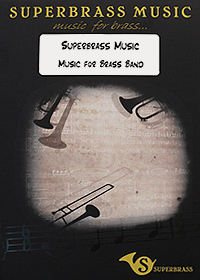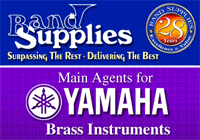The Battle of the Cornets
21-Apr-20054BR looks at the three leading models of cornet that are now being produced to try and capture the important and potentially lucrative young student market to find out which one is the best of the bunch from a Besson, Yamaha and a Jupiter.

All three were lent to us by Trevada Music where all three instruments can be purchased.
Introduction:
Walk into any bandroom in the world when there are young children being taught to play a brass instrument, and the chances are that at least 60% of them are learning their first notes on a cornet.
It is the most important instrument they will ever play; the first chance for them to fall in love with the physical and emotional pleasure of blowing into a metal tube and finding out somewhat miraculously that what comes out of the end can be governed exactly as they wish it to be. Loud, quiet, hard, soft, brilliant or gentle – the making of a personal musical sound.
There is no real trick to it. A good teacher and the implementation of proper technique and the rest comes naturally – or comes easier if what they actually blow into has some semblance of being well built and fit for the task asked of it. Nothing you see, can dent a young child's confidence more than for them to try their best, only to be let down by the one thing they have no real control over – the instrument itself.
If you are to retain a child's interest from the very earliest days, through to the point where they make the decision to make playing a brass instrument a life long passion, then you need them to perform on an instrument that has the ability to encompass their development from the early shoots of promise to the sapling years of eager exploration. This is the market place therefore for bespoke student model cornets and their like.
Years ago, the choice of cornet for the young player was primarily governed by what was available in the band cupboards. Patched up cornets like old wounded soldiers would be pressed into service way after their pension age for little hands and fingers to fiddle and potch with. As long as you could blow them, then they were worthy of being played.
Their names are like fallen heroes of our youth: the Regent, the Westminster, the Imperial – grand sounding titles as British as a BSA motorbike and usually built to the same specifications. They were sturdy and utilitarian - like post war clothing, and looked as if the same committee's designed them who gave the 1960's the high rise tower block and Morris Minor car.
Like the BSA and the Morris Minor in the 1970's, they were also superseded by the new imports from Europe and especially the Far East, with names that promised oriental technology at third world prices. The Brits never recovered and the Regent, the Westminster and the Imperial gave way to Yamaha, Courtois and Bach.
Today though, the market place has become a real fighting ground for new and technologically advanced models, built to attract the eye of the young performer and the pocket of their parents. It is a market place where quality and value for money are the overriding factors, in gaining what could prove to be (like bank accounts and choice of football teams) a lifelong association with a brand.
The three main instruments battling it out at present for market leadership in this sector are the following: The Besson BE1020, the Yamaha 2330II and the Jupiter JCR 520M. Each has its strengths and weaknesses, each has it pro and cons, but which one do we think is the best?
We have had the chance to play on all three instruments over the past few weeks, and we have used our usual criteria to measure them against each other.
The categories are:
1) Build Quality/Design
2) Intonation
3) Ease of Blowing/Tonal quality
3) Overall performance/Value for money
Each category can score up to a maximum of 25 points to give an overall score out of 100.
This is what we thought.
Build Quality/Design:
We understand that all three are not made in the UK, but that certainly has not meant that so-called ‘traditional' British craftsmanship has been lost. It was something of an overrated tradition in any case, and having them now made in India, Taiwan or Japan now means little or nothing in terms of quality or design.
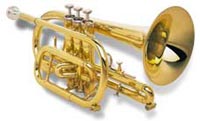 Jupiter:
Jupiter:
Up until a few years ago, Jupiter instruments, and especially their cornets had the feel of being put together with spit and Bostick glue, and would not have been out of place if a presenter on Blue Peter had just knocked one up out of sticky back plastic and a few of your Mam's Fairey Liquid bottles.
Not so now, with the Bright Silver Plate finish well burnished, but with the odd ‘shadow' and a quite sturdy feel to the instrument in the hand. It is neutrally balanced with the centre of gravity not leading to the instrument having a heavy front end and bell, which in youngsters could lead to the development of a poor embouchure.
The tolerances on the slides are good and everything fits together with neat joints and seals. The water keys though are out of the Penny Bazaar with springs that couldn't get a decent bounce out of Zebeddee in the Magic Roundabout let alone stay the course of being open and shut a million and one times through little hands and over moist mouths.
Unfortunately the same goes for the valves as well – Monel pistons they maybe, but the ones we had were rather sluggish and lacked ‘feel'. The valves made an annoying ‘clunking' sound when depressed and the valve tops and bottoms are not the greatest bits of metallurgy we have ever come across. The other bits and bobs are OK – the braces are well put together and give the instrument a rigidity, but the first valve hook is poorly positioned even for a fairly small hand, although the third valve slide is better. The lack of a lyre holder point is a poor oversight.
Overall – just a little below par for us: 18 points
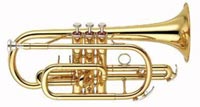 Yamaha:
Yamaha:
Yamaha overcame their image problems a long while ago and are now recognised as high quality makers of brass instruments across their entire range. This model has a lot of characteristics of the higher spec ‘Maestro' model (it looks as if it shares the same floor plan design), and therefore much of that is reflected in this model as well.
The BSP finish is very good indeed – no bleeds or shadows whilst the instrument has a slightly heavier feel to it – the old ‘ping' test of flicking the bell with your nail gives a satisfying ring to it – like closing the door on a Lexus car, rather than the Proton of the Jupiter.
Slides and seals are also very good with the tolerances tight yet flexible enough on the slides to be ushered open with little undue force. The water keys have proper springs and the lack of a centre brace on the main tuning slide does not affect the rigidity of the instrument in the hand.
The Monel valves are very good as well – centre sprung in stainless steel giving a fluid action, whilst the valve tops and bottoms also have a quality look and touch about them. The first valve hook though is once again poorly positioned, as is the third slide hook, which is in a fixed position.
The one major minus point though is the heavy yellow brass bell which means the instrument has a heavy front end that forces the young player to really make an effort to keep the instrument in a good embouchure position.
We were left with the impression that this was a hybrid offshoot rather than a specifically designed model for the young student.
Overall – lots of quality in the build, but rather heavy and lacking a little thought: 21 points
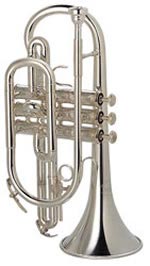 Besson:
Besson:
Besson have been around a long time, but have gone through the hoops a bit in terms of quality over the past few years. They have been making improvements though and by shipping out the production to a new factory in India they have been able to design and produce a brand new student model cornet.
The BSP is very good – no bleeds or shadows and there is a nice neutral balanced feel to the instrument in the hand. It is sturdy (although not as heavy as the Yamaha) and the braces give it a rigidity. The ‘ping' test gives off a nice sound as well – more BMW Mini than MG Rover, and the slides and seals are well put together.
The water keys are OK – not quite in the Yamaha class but the tolerances on the slides are fine – smooth and easy to use. The first valve slide hook is a bit fiddly, but the third slide hook can be moved and delivers a good firm action.
The Monel valves are centre sprung in steel and are neat and well crafted with a fluid and crisp action whilst the valve tops and bottoms look as if they have been designed with the job in mind.
The big plus point though is the design – it looks like what a proper cornet should, from the flared bell to the neat little detail points on the valves and leadpipe. Youngsters like good looking things, and this is as eye catching as Brittany Spiers in a crop top.
Overall – a good looking piece of work, well thought out and with good build quality: 22 points
Intonation:
Although young players can at times make some notes sound like any other notes, there is still a need to ensure that the basic intonation of the instrument they play is very good. If a player has to pull out their main tuning slide two inches to get in tune with the player next to them it is a fair bet that it is not all their fault.
Yamaha:
Quite simply excellent. There was little we could fault with the instrument in terms of intonation – right through the range. Even when we gave it a bit of ‘welly' it stayed remarkably secure and even the traditional problem notes above the stave of top G's and A's were pretty accurate.
The mid range was spot on, and judicious use of the first valve hook gave flexibility that soon eradicated any niggles. The problem though was that using the first valve hook was a difficult task and meant a distinct movement of the holding hand – not the best way of maintaining a good embouchure if done quickly.
Below the stave the instrument was also true and secure, so even young third cornet players could enjoy themselves on the afterbeats without giving cause for concern to their MD.
Overall – excellent. Just the niggle with the first valve hook losing a point or two: 23 points
Besson:
Very good as well. Not quite as secure throughout the range as the Yamaha, but still more than good enough for developing players. It was only at the edges of the range and dynamics that things went a little peetong – giving it the full hog meant that the G's and A's above the stave went sharp.
The mid range though was as good as the Yamaha – no problems to report here and as secure a Labour majority in the Welsh valleys, and the better positioned first valve hook meant that little movements in or out could be achieved with a firm bit of thumb work, and not by moving the whole hand.
Below the stave it was also very good – again just losing a little security when trying to sound like a baritone - but then, what well mannered third cornet player would ever want to sound like one of those?
Overall – more than good enough as long as you don't try to blow the thing straight: 21 points
Jupiter:
OK. Not as good as either of their competitors, but still a decent enough. When we really blew it though it went as wonky as Man Utd's away form, but if kept in check it was passable. Don't try and raise the roof though on the high stuff.
Mid range playing was fine – no real problems to report with the exception of the terrible first valve slide hook, which was just about impossible to use in any constructive manner. It seems to be there for appearances sake and would take a man with a fist the size of George Forman to use with any accuracy. Not good.
Below the stave things were much better, but again the lack of a workable trigger on the first slide could mean difficulties.
Overall – OK means OK – nothing more nothing less: 19 points
Ease of blowing/Tonal Quality:
Besson:
We liked this very much indeed. The 11.68mm bore and 118mm is the middle size of the three, and for a younger student this was just perfect. Too big and the student could try too hard to fill the instrument and develop bad habits, but this has been pitched just right to encourage tonal and dynamic development.
Even at the extremes it was easy and free blowing and we felt it really encouraged the student to make a good sound. It has a nice bright timbre as its natural sound, but can be darkened if used with a bit of intelligence and thought. Very classy.
Overall – very impressive and a joy to play: 23 points
Jupiter:
Not quite in the same league this – all a bit tinny and over bright in timbre, but surprisingly easy blowing throughout the range.
The bore is 11.60mm, which is the smallest of the three, and the bell 11.68mm - although to be truthful we couldn't really make any real distinction. Perhaps we misread this one a bit. It just seemed a bit constricted for us in the upper register and a bit loose down below the plimsoll line of the stave when we opened the throat a little. But then again what are you expecting a young student to play like – Maurice Murphy?
Overall – not quite a shining example but good enough to do what is required: 19 points
Yamaha:
We were stuck between a rock and a hard place here. Is it a wannabe ‘Maestro' or a student model with big ideas about itself? The result was that it never quite sounded either and was a bit dull and matt of finish in the timbre department.
As hard as we tried the instrument just sounded ‘dead', and we think the biggest bore of 11.73mm and largest bell of 119mm may have been the cause. Bigger than the Besson, and allied to the weight of construction it just made things sound like a night out at the Darby and Joan whist drive – not the most exciting time of your life.
A pity this as your expect it to be so much better as you can pump a great deal of effort and air through it.
Overall – a bit of a disappointment given the quality of the construction. Perhaps a smaller bore would have helped? - 22 points
Overall performance/Value for money
This is perhaps the most important criteria for parents and bands when considering which of the three cornets they would like to buy. In this day and age, everyone wants value for money without the quality of the goods being compromised. So which of the three came out top here.
Jupiter:
Surprisingly the Jupiter is retailed at £449.00 (in BSP) but you can pick one up around the £275.00 Mark. Our friends at Trevada are selling them at £265.00, which on the face of it represents a pretty good deal, and for the money, it offers a good basic model, which does what it says on the tin, but no more.
It comes with a wooden frame case, which is a bit plasticky with the type of sticker on the side that looks like it has been pinched off the back of a car, and offers very little storage room for mutes or music (just enough room for a small Gameboy perhaps). The case is sturdy enough to take all our little angels bangs and bruises in its stride, but what use is it if they lose the music they are going to play?
It isn't lockable either and the handle, locks and hinges are pop riveted into the case, so may not last a great deal of teenage abuse. The instrument comes with a standard mouthpiece (which we would leave alone), a cleaning cloth and valve oil, but no instruction manual to show our little darlings that trying to bang valves and slides into place without lubrication is not a good idea.
The instrument though just disappointed – a lack of real quality about it compared to its rivals, and you do wonder if it has been made to last. How long before little Jenny comes asking for a new spring for the water key?
Overall – not a bad model cornet, but given the competition it is up against, what it offers for the money falls a little below what we would expect: 18 points
Yamaha:
The Yamaha retails at a rather heavy in the pocket £509.00 but can be picked up around the £380.00 mark. Trevada do this model at £370.01. This is a quality made instrument, but you are expected to pay for that quality as well.
The instrument comes in a well made wooden case that is bigger than the Jupiter, a bit more plush inside and with just enough room for a couple of mutes and a tube of Smarties. The fixtures and fittings have a better feel to them as well, although once more they are pop riveted into the case and may not last the odd teenage tantrum. It is not lockable either, which again is a minus point, and what do the kids do with their music?
A super instruction manual (and silent brass mute system leaflet just to encourage parents to invest in a means of not actually hearing their offspring practice too loudly in those early days) is tucked away in the case, as is a cleaning cloth, valve oil and mouthpiece. We would recommend that you ask about having a different one to the 11E4 that is provided, as this isn't the best of the range for a youngster to learn their trade on.
The instrument is another fine example of what Yamaha now churn out, although we still think a bit more thought and originality could have gone into it. It offers a lot, but takes some playing and the price is a little prohibitive when you think that little Jimmy may well want to take up Karate a couple of months down the line.
Overall – a quality instrument at a bit of a premium price, may be asking too much for what it can give for a young player: 21 points
Besson:
The Besson retails at £344.00 and can be picked up for around £240.00. Trevada do it £220.00. Yes, that is around £220.00 sovs. How do they do it? Making it in India helps, but given the tight purse strings of many hard working parents and bands, this is fairly remarkable value for money for an instrument as well made and good looking as this. A complete cornet section can be kitted out for under two grand - and that is really appealing.
It is the only one of the three to come in a ‘soft' case, although it is very well put together with sturdy zippers and plenty of padding surrounding the little gem inside. It comes with a cloth, valve oil and mouthpiece (although not a Denis Wick which is a pity – so ask about getting one as it will be a better long term investment than the one provided), and joy of joys, it has plenty of room in a bespoke outside compartment for your little maestro's music! No instruction manual though.
It isn't locakable either, although you could use a small lock like a travel bag on the zip fasteners. The case is light and may take a bit of damage, but it is more than good enough to do the job with room to spare for mutes and the odd make up bag from ‘Claire's Accessories'.
A cracking instrument this – made for the job in mind, and also made with quality in mind too. Besson have learnt their lesson and have produced a fine student model that offers a great deal for very little dosh.
Overall – a little cracker indeed. A quality product that looks as good as it plays. A very impressive overall package: 23 points
The Result:
1st: Besson BE1020 (22/21/23/23) = 89 points
2nd: Yamaha 2330II (21/23/22/21) = 87 points
3rd: Jupiter JCR 520M (18/19/19/18) = 74 points
Overall Comment:
The Besson and the Yamaha are in a different league to the Jupiter in what is a very competitive sector of the brass instrument market.
The Jupiter isn't a bad instrument at all. It just lacks that build quality and the overall excellence of the other two, whilst for the price it doesn't quite deliver what you would expect it to.
The Yamaha is a real quality instrument, but it asks you to pay a premium price for it as well, and in this market that may be a bit too much to expect. It also feels and plays as if it is a hybrid version of the top of the range ‘Maestro', which might seem fine, but means that it lacks a bit of originality and thought for the young student player that it should have in mind.
The Besson comes top because it offers the best overall package for student players on the market. It has a quality feel to it, and has crucially been designed for the task of helping develop the young player. It is a fine instrument that looks and plays the part, and given the price, it fully deserves to come out as the best of the bunch. A little gem in fact.
Specification:
Besson BE1020:
Bore: 11.68mm (medium large)
Bell: 118mm
Weight: 1129grms
Hand forged braces
Centre sprung steel valves
1st and 3rd slide crooks
Mouthpiece, cloth, soft case, valve oil
RRP: £344.00 (Bright Silver Plate)
Look for prices around: £230.00 - £250.00
Trevada Music Price: £220.00
Yamaha 2330II
Bore: 11.73mm (medium large)
Bell: 119mm
Weight: not given
Yellow brass bell
Monel centre sprung valves
1st and 3rd slide crooks
Mouthpiece, cloth, hard case, valve oil, instruction manual
RRP: £509.00 (Bright Silver Plate)
Look for prices around: £380.00 -£400.00
Trevada Music Price: £370.00
Jupiter JCR 520M
Bore: 11.60mm
Bell: 116mm
Weight: not given
Monel metal piston valves
Wood frame case
1st and 3rd valve slide crooks
Mouthpiece, cloth, valve oil
RRP: £449.00 (Bright Silver Plate)
Look for prices around: £275.00 - £300.00
Trevada Music Price: £265.00





